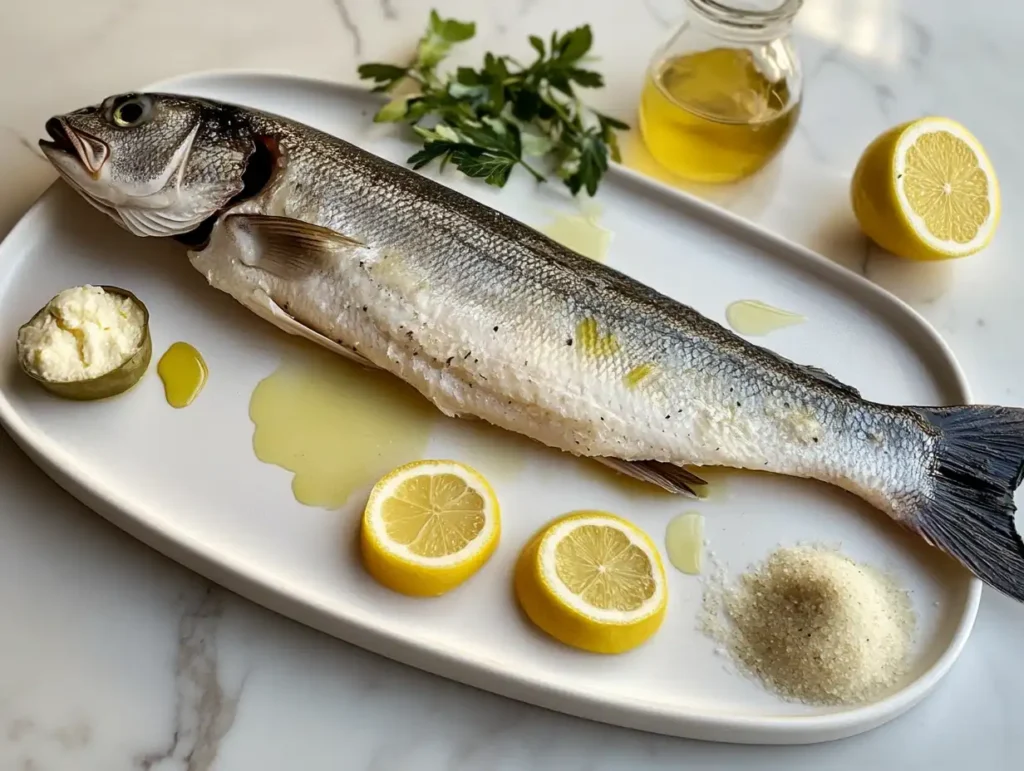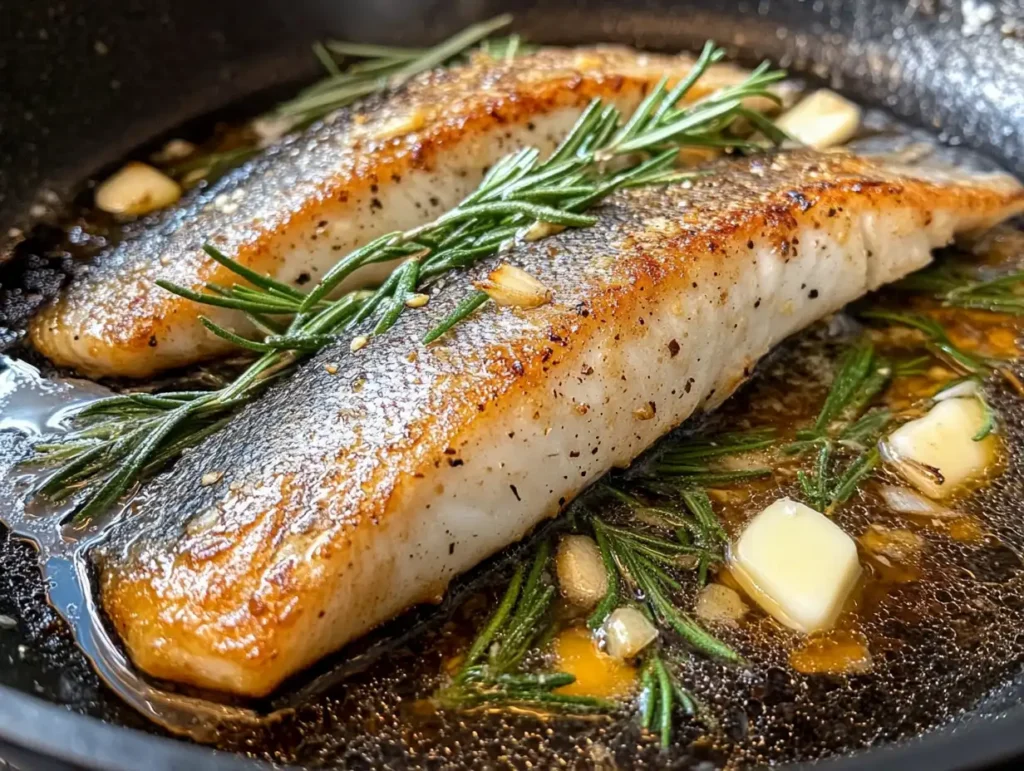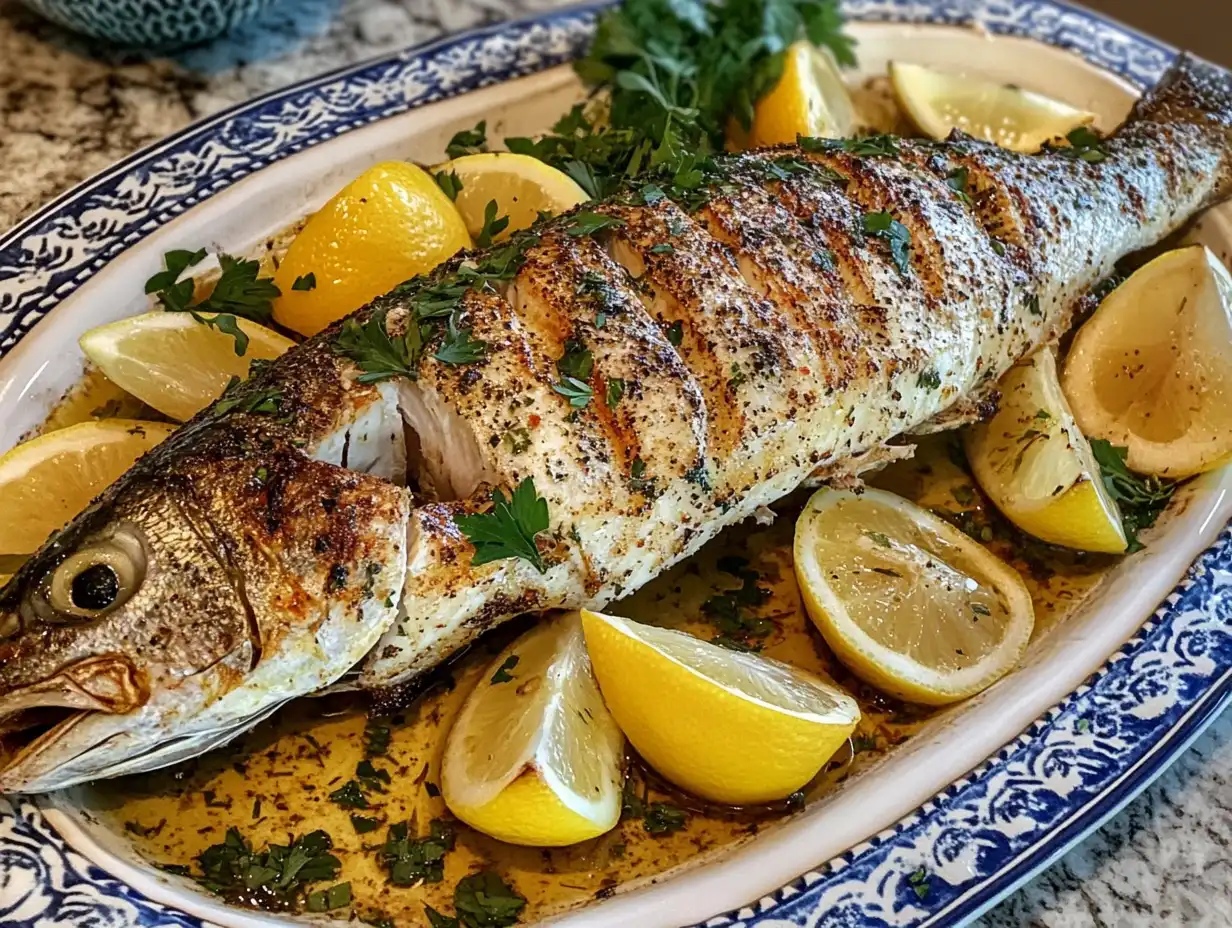Table of contents
Introduction
Branzino, also known as European seabass, has gained significant popularity in recent years due to its delicate flavor, ease of preparation, and numerous health benefits. Native to the Mediterranean Sea and the eastern Atlantic Ocean, branzino is a favorite in many cuisines, particularly in Mediterranean and Italian dishes.
Branzino, also known as European seabass, has gained significant popularity in recent years due to its delicate flavor, ease of preparation, and numerous health benefits. Native to the Mediterranean Sea and the eastern Atlantic Ocean, branzino is a favorite in many cuisines, particularly in Mediterranean and Italian dishes.
But what makes branzino so appealing? Is branzino a good fish to eat? This article dives into everything you need to know about branzino, exploring its nutritional profile, cooking versatility, and overall sustainability to answer the key question: Is branzino a good fish to eat?
What is Branzino?
Branzino is a sleek, silver-scaled fish scientifically known as Dicentrarchus labrax. It thrives in both marine and brackish waters and is commonly found along the Mediterranean coastline and the eastern Atlantic Ocean, from Norway to Senegal. Known for its tender, flaky white flesh, branzino is a mild-flavored fish that is well-suited to various cooking techniques.
Whether you’re new to seafood or a seasoned gourmet, you may wonder, is branzino a good fish to eat for everyone? Its mild flavor and versatility in the kitchen often make it a crowd-pleaser.
Nutritional Value of Branzino

Branzino is not just a delicious addition to your plate—it’s also packed with nutrients that contribute to a healthy diet. A 100-gram serving of branzino provides the following:
- Calories: Around 97 calories
- Protein: Approximately 20 grams
- Fat: Around 2 grams, primarily healthy fats
- Omega-3 Fatty Acids: A good source of these essential fats, which promote heart and brain health
- Vitamins: High in vitamin D and B vitamins, especially B12, which supports energy production and red blood cell formation
- Minerals: Contains potassium, selenium, and phosphorus, essential for bone health, immune support, and cellular function
Branzino’s low calorie and high protein profile make it an excellent choice for weight management and muscle repair. Its omega-3 content, though not as high as fatty fish like salmon, is still beneficial for overall health.
Health Benefits of Eating Branzino
Including branzino in your diet is an excellent choice for overall health, leading many to wonder, “Is branzino a good fish to eat regularly?” The answer lies in its high protein content, essential omega-3 fatty acids, and rich vitamin profile.
Including branzino in your diet can yield numerous health advantages:
1. Promotes Cardiovascular Health
The omega-3 fatty acids in branzino play a crucial role in reducing inflammation and lowering bad cholesterol levels. These effects help prevent heart disease and promote a healthy circulatory system.
2. Supports Brain Health
Omega-3s, particularly DHA, are essential for maintaining cognitive function and reducing the risk of neurodegenerative diseases. Branzino’s omega-3 content contributes to brain health for people of all ages.
3. Enhances Bone Strength
The presence of vitamin D and phosphorus in branzino supports bone health, reducing the risk of osteoporosis and promoting strong bones and teeth.
4. Boosts Immune System
Selenium, a powerful antioxidant found in branzino, helps combat oxidative stress and strengthens the immune system.
5. Aids Muscle Growth and Repair
With 20 grams of protein per serving, branzino is an excellent source of lean protein. It helps repair muscle tissue and supports overall growth, making it a great option for athletes or individuals recovering from illness.
6. Ideal for Weight Management
Branzino is low in calories and fat, making it a satisfying and nutritious choice for those looking to maintain or lose weight without sacrificing flavor.
Taste and Culinary Appeal of Branzino
One of the reasons branzino is so popular is its mild, sweet flavor that appeals to even those who aren’t typically fans of seafood. Its white flesh is tender and flaky, offering a clean taste that pairs well with a variety of seasonings and cooking styles.
Flavor Profile
- Mild Sweetness: Branzino’s flavor is delicate, without the strong “fishy” taste associated with some seafood.
- Buttery Texture: Its meat is moist and buttery, making it ideal for both simple preparations and more elaborate dishes.
- Adaptability: Branzino readily absorbs the flavors of herbs, spices, and marinades, making it a versatile choice for culinary experimentation.
Why Chefs Love Branzino
Branzino is often called a “chef’s fish” due to its ease of preparation and consistent quality. Whether grilled, roasted, or steamed, it holds up well to various cooking techniques and presents beautifully on the plate. Its skin, when crisped, adds a satisfying texture and an additional layer of flavor.
Popular Ways to Cook Branzino

Branzino is as versatile as it is delicious. Its firm but flaky flesh and mild taste make it suitable for a wide range of cooking methods. Below are some of the most popular ways to prepare it:
1. Grilling
Grilling branzino enhances its natural sweetness and imparts a smoky flavor. Chefs often prepare it whole, stuffing the cavity with herbs like rosemary and thyme and brushing the skin with olive oil to achieve a crispy finish.
2. Roasting
Whole roasted branzino is a classic Mediterranean preparation. The fish is often seasoned with lemon, garlic, and olive oil, then baked until the flesh is tender and infused with aromatic flavors.
3. Pan-Searing
For those who prefer a simpler approach, pan-searing branzino fillets is an excellent option. The skin crisps up beautifully in a hot pan, while the flesh remains moist and flavorful.
4. Steaming
Steaming branzino preserves its delicate flavor and moist texture. This method is popular in Asian cuisines, where the fish is typically served with soy sauce, ginger, and scallions.
5. Mediterranean-Style Dishes
Branzino shines in traditional Mediterranean recipes, often paired with ingredients like olives, capers, tomatoes, and fresh herbs. These recipes highlight the fish’s mild flavor while staying true to its origins.
Is Branzino Sustainable?
Sustainability is an important consideration when choosing seafood, and branzino offers a relatively sustainable option compared to many other fish species. However, understanding the difference between wild-caught and farmed branzino is key to making an informed choice.
Wild-Caught Branzino
Wild branzino is primarily fished in the Mediterranean and Atlantic waters. While wild-caught fish generally have a smaller environmental footprint, overfishing concerns have led to regulations to protect branzino populations in the wild. Certified sustainable fisheries ensure that wild-caught branzino is harvested responsibly.
Farmed Branzino
Most branzino available on the market today is farmed, particularly in Mediterranean countries such as Greece, Turkey, and Italy. Advances in aquaculture practices have made branzino farming more sustainable by reducing waste and improving feed conversion ratios. Reputable certifications like ASC (Aquaculture Stewardship Council) or Global GAP indicate that the farming methods meet high environmental and ethical standards.
Environmental Impact
Compared to larger fish like tuna or salmon, branzino farming has a lower carbon footprint and is less resource-intensive. Additionally, branzino is often raised in well-managed systems that minimize habitat destruction and reduce the use of antibiotics.
Tips for Sustainable Choices
- Look for certifications such as MSC (Marine Stewardship Council) for wild-caught branzino or ASC for farmed varieties.
- Choose locally sourced branzino to reduce transportation emissions.
- Avoid purchasing branzino from unregulated sources to ensure you’re supporting responsible fishing or farming practices.
Branzino vs. Other Fish
Branzino is often compared to other popular fish, such as salmon, cod, and tilapia. Here’s how it stacks up in terms of flavor, nutrition, and sustainability:
1. Flavor Comparison
- Branzino: Mild, sweet, and delicate, making it a versatile option for a wide range of dishes.
- Salmon: Rich and fatty, with a strong flavor that pairs well with bold seasonings.
- Cod: Mild and slightly sweet, with a firmer texture than branzino.
- Tilapia: Very mild and neutral, often considered less flavorful than branzino.
2. Nutritional Comparison
- Branzino: High in protein, omega-3s, and low in calories, offering a balanced nutrient profile.
- Salmon: Extremely high in omega-3s and vitamin D, but also higher in calories and fat.
- Cod: Low in fat and calories, with moderate protein levels but fewer omega-3s than branzino.
- Tilapia: Low in omega-3s compared to branzino but a good source of protein.
3. Sustainability Comparison
- Branzino: Farmed options are generally more sustainable than many farmed salmon varieties.
- Salmon: Wild-caught salmon is sustainable when sourced responsibly, but farmed salmon often faces sustainability challenges.
- Cod: Overfishing concerns make some cod species less sustainable.
- Tilapia: Widely farmed with lower environmental impact, but often criticized for lacking omega-3 content.
Potential Risks of Eating Branzino
While branzino is generally considered a healthy and safe choice for most people, there are a few potential risks to be aware of:
1. Mercury Levels
Branzino is a relatively small fish, which means it accumulates less mercury compared to larger predatory species like tuna or swordfish. However, some levels of mercury may still be present. For most people, occasional consumption is safe, but pregnant women, nursing mothers, and young children should limit their intake to reduce exposure to mercury.
2. Allergies
As with all seafood, individuals with fish allergies should avoid branzino. Allergic reactions can range from mild symptoms, such as hives or itching, to more severe responses like difficulty breathing or anaphylaxis.
3. Contaminants in Farmed Branzino
Poorly managed fish farms may result in branzino with higher levels of contaminants, such as antibiotics or pollutants. Choosing branzino from reputable sources with certifications like ASC ensures that the fish is raised under safe and ethical conditions.
4. Bones
When served whole, branzino contains small bones that can pose a choking hazard, especially for children. Proper preparation and deboning can mitigate this risk.
Who Should Eat Branzino?
Branzino is a versatile fish that fits well into various diets, making it suitable for a wide range of individuals:
1. Health-Conscious Individuals
Thanks to its lean protein content and omega-3 fatty acids, branzino is a great choice for those looking to maintain a healthy weight, support cardiovascular health, and improve overall wellness.
2. Children and Seniors
Branzino’s mild flavor and tender texture make it appealing to children and seniors who may prefer less intense flavors. Its nutrient density also supports growth in children and bone health in seniors.
3. Athletes and Active Lifestyles
With 20 grams of protein per serving, branzino is ideal for athletes and individuals with active lifestyles who need lean protein for muscle recovery and sustained energy.
4. Mediterranean Diet Followers
Branzino is a cornerstone of Mediterranean cuisine, making it a natural fit for those following a Mediterranean diet. It pairs beautifully with heart-healthy ingredients like olive oil, garlic, and fresh vegetables.
5. Pescatarians
For those who avoid meat but include seafood in their diet, branzino is an excellent addition due to its nutritional profile and variety of preparation options.
Who Should Be Cautious?
- Pregnant and breastfeeding women should monitor their intake to avoid mercury exposure.
- Individuals with seafood allergies must avoid branzino altogether.
Branzino in Mediterranean Culture
Branzino holds a special place in Mediterranean cuisine and culture, often celebrated as a symbol of simplicity and natural flavors. Its popularity stems from its abundance in the region and its adaptability to various cooking methods.
1. A Staple in Mediterranean Cuisine
In Mediterranean countries such as Italy, Greece, and Spain, branzino is a key ingredient in traditional dishes. Whether roasted with olive oil and lemon, grilled with fresh herbs, or baked in a salt crust, branzino is prized for its ability to absorb the flavors of local, seasonal ingredients.
2. A Highlight at Celebratory Meals
Branzino is often served during special occasions and family gatherings in Mediterranean households. Its preparation and presentation—frequently served whole with head and tail intact—make it a visually stunning centerpiece for festive meals.
3. Health Alignment with the Mediterranean Diet
As a lean source of protein and omega-3s, branzino aligns perfectly with the principles of the Mediterranean diet, which emphasizes fresh, nutrient-rich foods. Its light and clean flavor make it a frequent choice for dishes paired with vegetables, legumes, and whole grains.
Buying and Storing Branzino
Ensuring the freshness and quality of branzino begins with smart purchasing and proper storage. Here are some essential tips to help you select the best branzino and keep it fresh until cooking.
1. Buying Fresh Branzino
When shopping for branzino, look for the following indicators of freshness:
- Bright, Clear Eyes: Fresh branzino should have clear, shiny eyes, not cloudy or sunken.
- Firm Flesh: Gently press the fish; the flesh should bounce back and feel firm, not mushy.
- Mild Smell: Fresh branzino has a clean, ocean-like scent. Avoid fish with a strong, unpleasant odor.
- Shiny, Intact Scales: The scales should be smooth and shiny, not dull or flaking.
2. Choosing Between Whole and Filleted Branzino
- Whole Branzino: Ideal for roasting or grilling, as the bones and skin enhance the flavor.
- Fillets: A convenient option for quick pan-searing or steaming. Ensure fillets are moist and have no discoloration.
3. Storing Branzino
- Refrigeration: Store fresh branzino in the coldest part of your refrigerator, ideally on ice or in an airtight container. Use it within 1-2 days of purchase.
- Freezing: If you’re not cooking branzino immediately, freeze it in vacuum-sealed packaging or airtight freezer bags to preserve its quality. It can be stored in the freezer for up to three months.
4. Thawing Frozen Branzino
Thaw branzino in the refrigerator overnight or under cold running water. Avoid using warm water or microwaves, as these methods can compromise the texture and flavor.
Cooking Tips for Perfect Branzino
Preparing branzino to perfection requires attention to detail, especially when handling this delicate fish. Whether you’re cooking it whole or as fillets, the following tips can help you elevate its flavor and texture.
1. Preparing Branzino
- Deboning and Cleaning: If you’re cooking branzino whole, ask your fishmonger to gut, scale, and clean the fish. While cooking with bones enhances the flavor, you can debone the fish after cooking for easier serving.
- Scoring the Skin: For whole branzino, lightly score the skin with shallow cuts. This allows the seasoning to penetrate and prevents the fish from curling during cooking.
2. Seasoning Techniques
Branzino’s mild flavor pairs well with a variety of seasonings, but simplicity often works best:
- Use a combination of olive oil, salt, and pepper as a base.
- Add fresh herbs like thyme, rosemary, or parsley inside the cavity for aromatic infusion.
- Citrus fruits such as lemon or orange slices can enhance the fish’s natural sweetness.
3. Cooking Temperature and Timing
Branzino cooks quickly, and overcooking can dry out its tender flesh. Follow these general guidelines:
- Grilling: Cook whole branzino for 5-7 minutes per side over medium heat.
- Roasting: Bake in a preheated oven at 400°F (200°C) for 20-25 minutes or until the flesh flakes easily.
- Pan-Searing: Cook fillets skin-side down over medium-high heat for 3-4 minutes, then flip and cook for another 1-2 minutes.
4. Enhancing Presentation
Serve branzino whole for a dramatic and elegant presentation. Garnish with fresh herbs, citrus wedges, and a drizzle of olive oil for a restaurant-quality finish.
FAQs About Branzino
1. Is branzino better than salmon?
Branzino and salmon differ significantly in flavor, texture, and nutrition. While salmon has a richer, fattier taste with higher omega-3 content, branzino offers a lighter, more delicate flavor. Both are excellent choices depending on your preferences and dietary goals.
2. Does branzino taste fishy?
No, branzino is known for its mild and slightly sweet flavor, making it an excellent option for people who prefer less “fishy” seafood.
3. Is branzino a healthy fish to eat?
Yes, branzino is a healthy choice, as it is low in calories, high in protein, and a good source of omega-3 fatty acids, vitamins, and minerals.
4. Is branzino farmed or wild?
Branzino is available in both farmed and wild varieties. Most of the branzino on the market today is farmed, particularly from Mediterranean countries like Greece and Italy.
5. How can you tell if branzino is fresh?
Fresh branzino will have bright, clear eyes, firm flesh, and a clean, ocean-like smell. Avoid fish with dull scales, mushy flesh, or a strong odor.
6. Can you eat branzino skin?
Yes, branzino skin is edible and becomes delightfully crispy when grilled or pan-seared. It adds texture and enhances the flavor of the dish.
Is Branzino a Good Fish to Eat? Related Recipes and Tips
Branzino is celebrated for its delicate flavor, flaky texture, and versatility in cooking. To enhance your understanding and enjoyment of this fish, check out these related articles from Greedy Recipes:
- What is a Good Dinner Idea for Tonight?: Discover how branzino can be a centerpiece in quick, healthy, and delicious meals.
- What Type of Mushroom is Best for Pasta? A Comprehensive Guide: Explore side dish options that pair beautifully with the mild flavor of branzino.
- What Can You Use Instead of Sun-Dried Tomatoes?: Find creative ingredients to complement branzino’s taste in innovative recipes.
These articles offer insights and ideas to showcase branzino as a versatile and nutritious choice for your next meal.
Conclusion
Branzino is undoubtedly a good fish to eat, offering a harmonious blend of health benefits, culinary versatility, and sustainability. Its mild, sweet flavor and tender texture make it a favorite for both seafood lovers and those new to fish. With its high protein content, omega-3 fatty acids, and essential vitamins, branzino supports overall wellness while fitting into a variety of diets.
Whether grilled, roasted, or pan-seared, branzino adapts beautifully to diverse cuisines and cooking styles. When sourced responsibly, it is also an environmentally conscious choice. From its cultural significance in Mediterranean cuisine to its appeal in modern kitchens, branzino is a fish worth savoring.
